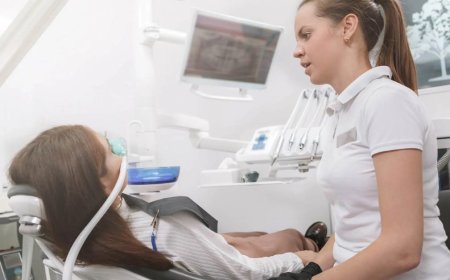IV Sedation Dentistry Safe and Comfortable Dental Care
Explore how IV sedation dentistry delivers safe and comfortable care by using controlled IV medication to calm patients and make dental treatments stress-free.

IV sedation dentistry has emerged as a powerful option for patients who seek relief from anxiety or discomfort during complex dental procedures. By administering sedative medication directly into the bloodstream through an intravenous line, dental teams can create a deeply relaxed state that allows patients to remain comfortable yet responsive.
This approach not only reduces fear and pain but also enables clinicians to perform treatments more efficiently and thoroughly. As awareness of IV sedation grows, more individuals are discovering that safe and comfortable dental care is within reach, even for extensive interventions that once felt intimidating.
Introduction to IV Sedation Dentistry
IV sedation dentistry involves the careful use of medications delivered directly into a patients vein to induce a state of deep relaxation. Unlike oral sedatives which must be absorbed through the digestive system, IV sedation provides rapid onset and precise control over dosage.
Patients feel calm and often experience little to no memory of the procedure itself. This rapid control is especially valuable for lengthy treatments, such as multiple extractions, implant placement, or full-mouth rehabilitation. By reducing movement and stress, IV sedation optimizes clinical conditions and contributes to better procedural outcomes.
How IV Sedation Promotes Patient Comfort
One of the most significant benefits of IV sedation dentistry is its ability to alleviate the fear that keeps many people from seeking proper oral care. Patients prone to dental phobia or those with strong gag reflexes can benefit immensely from a sedation level that keeps anxiety at bay without inducing full unconsciousness.
Throughout the appointment, vital signs such as heart rate, blood pressure and oxygen saturation are continuously monitored. If a patient experiences any discomfort, the dental team can adjust the level of sedation in real time. This responsiveness ensures that the patient remains in a safe and comfortable state throughout the entire process.
Safety Protocols and Provider Qualifications
Ensuring safety in IV sedation dentistry requires rigorous training and certification for both dentists and supporting staff. Clinicians must achieve proficiency in airway management and emergency response techniques.Many professionals compareACLS vs BLS to determine which certification best aligns with their practice needs.
Basic Life Support certification equips individuals with the essential skills necessary for managing general medical emergencies. Advanced Cardiac Life Support certification delves deeper into cardiovascular emergencies, making it invaluable for practices that offer deeper sedation services. By maintaining up-to-date credentials in these life support protocols, dental teams uphold the highest standards of patient care.
Lifelong Learning Through Live Dental CE Courses
The field of sedation dentistry is constantly evolving with new drugs, delivery systems and monitoring technologies. To stay current, many clinicians participate in interactive live dental CE courses that emphasize hands-on training and peer collaboration.
These courses cover topics such as patient selection criteria, sedation pharmacology, and risk mitigation strategies. By engaging in case-based discussions and simulated scenarios, practitioners refine their skills and reinforce best practices in IV sedation. This commitment to continuous education empowers dental teams to deliver ever safer and more comfortable care.
Global Workforce Integration for Sedation Providers
As demand for qualified sedation providers grows, dental practices increasingly consider candidates trained outside the United States. Prospective clinicians must navigate varying state regulations to secure licensure.
Those interested in opportunities here can consult a list ofstates that allow foreign trained dentists to identify where their credentials meet local requirements. Some jurisdictions mandate supplemental examinations or accredited postgraduate training.
Navigating these pathways not only broadens career prospects for international colleagues but also expands patient access to expertly delivered IV sedation dentistry.
Preparing for an IV Sedation Appointment
Successful IV sedation begins long before the first medication is administered. Patients attend a pre-operative consultation during which their medical history and current medications are reviewed in depth.
Individuals with chronic conditions or those taking certain medications may require additional medical clearance. In advance of the appointment, patients are instructed to fast for a specified period and arrange for a responsible adult to drive them home afterward.
Clear pre-procedure guidelines help ensure that sedation levels can be managed accurately and safely, resulting in a smoother experience for both the patient and the clinician.
What to Expect During Recovery and Aftercare
Recovery times following IV sedation can vary based on the medications and dosages used as well as individual patient factors. Most patients experience drowsiness for several hours after treatment and are advised to rest in a calm environment until full alertness returns.
Hydration and soft foods are recommended once the patient feels ready. The dental team provides tailored postoperative instructions addressing pain management, oral hygiene, and activity restrictions.
A follow-up call the next day ensures that recovery is progressing smoothly and that any questions or concerns are promptly addressed.
Frequently Asked Questions
How does IV sedation differ from oral sedation?
IV sedation delivers medication directly into the bloodstream, providing faster onset and more precise control than oral sedatives, which must pass through the digestive system before taking effect. Clinicians can adjust IV sedation levels instantly in response to the patient's needs.
Is IV sedation safe for individuals with dental anxiety?
When administered by properly trained providers with current certifications in life support protocols, IV sedation is very safe. Continuous monitoring of vital signs and oxygen levels ensures that any changes in a patient's condition are detected and managed promptly.
What certifications should a dentist have to offer IV sedation?
Dentists offering IV sedation should maintain a minimum of Basic Life Support certification. Many practices also require Advanced Cardiac Life Support to prepare for potential cardiovascular emergencies. Comparing ACLS vs BLS can help clinicians choose the right path.
Can foreign-trained dentists practice IV sedation in the US?
Licensure requirements vary by state. Prospective providers should review a list of states that allow foreign-trained dentists to determine where additional examinations or accredited training may be required.
How can dentists stay current on best practices for IV sedation?
Participating in live dental CE courses and industry conferences allows clinicians to learn about new sedation protocols, share case experiences with peers, and refine emergency response techniques.
Final Thoughts
IV sedation dentistry represents a significant advance in patient-centered oral care by combining deep relaxation with rigorous safety standards. From comprehensive training in ACLS vs BLS and participation in hands-on live dental CE courses to welcoming skilled professionals from around the globe via states that allow foreign-trained dentists, the landscape of sedation dentistry continues to evolve. As more patients discover the comfort and peace of mind afforded by IV sedation, dental teams are poised to deliver safer, more efficient, and more compassionate care than ever before.

































